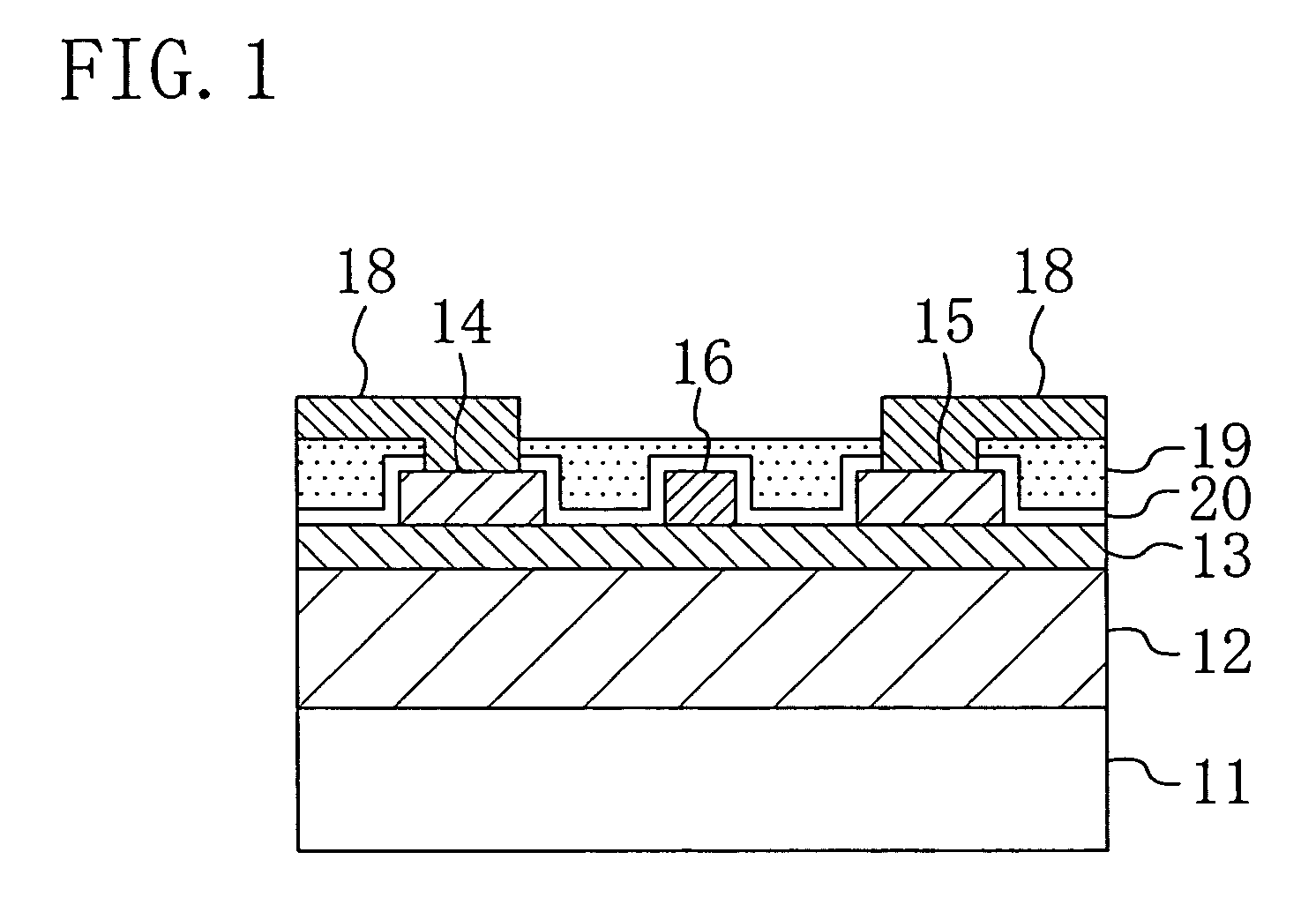Semiconductor device
a technology of semiconductor devices and semiconductors, applied in the direction of semiconductor devices, semiconductor/solid-state device details, electrical devices, etc., can solve the problems of uniform heat generation inside the device, greater amount of power consumed, and heat generated in the operating layer, so as to achieve significant heat uniformization effect and save spa
- Summary
- Abstract
- Description
- Claims
- Application Information
AI Technical Summary
Benefits of technology
Problems solved by technology
Method used
Image
Examples
first embodiment
[0023]A semiconductor device according to a first embodiment of the present invention will be described with reference to FIG. 1.
[0024]FIG. 1 schematically shows a cross section of the semiconductor device according to the first embodiment.
[0025]Referring to FIG. 1, a barrier layer 13 of AlxGa(1-x)N (0≦x≦1) is stacked on an operating layer 12 of GaN formed on a substrate 11, and the operating layer 12 and the barrier layer 13 form a heterojunction interface. A source electrode 14 and a drain electrode 15 are formed away from each other, and a gate electrode 16 is formed between the source electrode 14 and the drain electrode 15. Bonding pad 18 is also provided connected to the source electrode 14 and / or the drain electrode 15. The surfaces of these electrodes and the barrier layer 13 are coated with an insulating film 20 made of a carbon compound (for example, titanium carbon (TiC) or aluminum carbon (AlC)) with high adhesion. The top of the insulating film 20 is coated with a diamo...
second embodiment
[0026]A semiconductor device according to a second embodiment of the present invention will be described with reference to FIG. 2.
[0027]FIG. 2A schematically shows a cross section of the semiconductor device according to the second embodiment.
[0028]Referring to FIG. 2A, a barrier layer 13 of AlxGa(1-x)N (0≦x≦1) is stacked on an operating layer 12 of GaN formed on a substrate 11, and the operating layer 12 and the barrier layer 13 form a heterojunction interface. A first source electrode 14A and a drain electrode 15 are formed away from each other, and a gate electrode 16 is formed between the first source electrode 14A and the drain electrode 15. The surfaces of these electrodes and the barrier layer 13 are coated with an insulating film 20 made of a carbon compound (for example, titanium carbon (TiC) or aluminum carbon (AlC)) with high adhesion. The top of the insulating film 20 is coated with a diamond film 19 having high thermal conductivity and excellent heat radiation property ...
third embodiment
[0031]A semiconductor device according to a third embodiment of the present invention will be described with reference to FIG. 3.
[0032]FIG. 3 schematically shows a cross section of the semiconductor device according to the third embodiment.
[0033]Referring to FIG. 3, a barrier layer 13 of AlxGa(1-x)N (0≦x≦1) is stacked on an operating layer 12 of GaN formed on a substrate 11, and the operating layer 12 and the barrier layer 13 form a heterojunction interface. On the both sides of a source electrode 14, a pair of drain electrodes 15 are formed away from each other, and a pair of gate electrodes 16 are formed between the source electrode 14 and the pair of drain electrodes 15, respectively. The surfaces of these electrodes and the barrier layer 13 are coated with an insulating film 20 made of a carbon compound (for example, titanium carbon (TiC) or aluminum carbon (AlC)) with high adhesion. The top of the insulating film 20 is coated with a diamond film 19 having high thermal conductiv...
PUM
 Login to View More
Login to View More Abstract
Description
Claims
Application Information
 Login to View More
Login to View More - R&D
- Intellectual Property
- Life Sciences
- Materials
- Tech Scout
- Unparalleled Data Quality
- Higher Quality Content
- 60% Fewer Hallucinations
Browse by: Latest US Patents, China's latest patents, Technical Efficacy Thesaurus, Application Domain, Technology Topic, Popular Technical Reports.
© 2025 PatSnap. All rights reserved.Legal|Privacy policy|Modern Slavery Act Transparency Statement|Sitemap|About US| Contact US: help@patsnap.com



